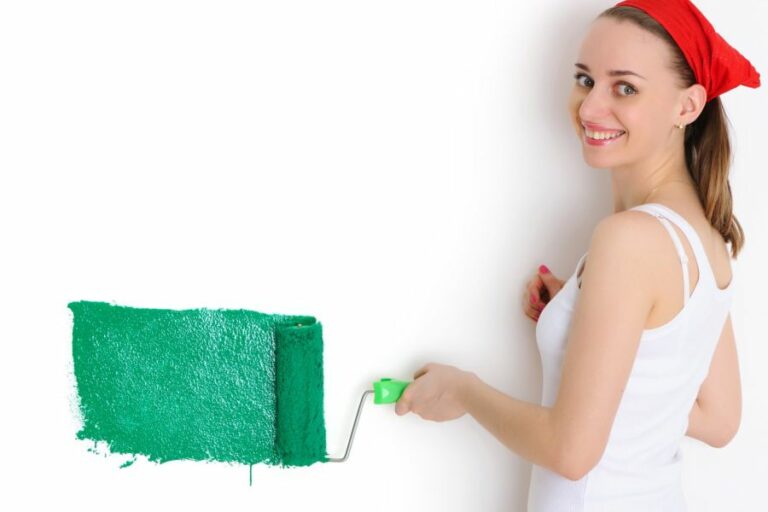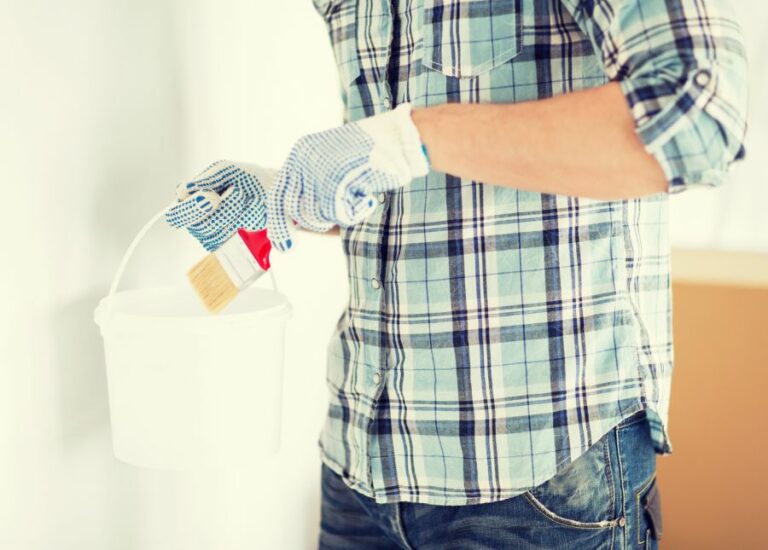Painting Techniques For Indoor Walls, 25 Things You Should Know
Are you ready to transform your indoor space with a fresh coat of paint but unsure of the best techniques to achieve a professional-looking result? Look no further! We have the expertise to guide you through the essential painting techniques for indoor walls, ensuring a smooth and stylish finish. Get ready to unleash your creativity and beautify your living space with confidence and ease.
Painting techniques for indoor walls:
To paint indoor walls, choose high-quality brushes, rollers, and paint. Prepare the surface by cleaning, filling holes, and sanding—prime the wall for an even base. Test colors on a small section under different lighting. Use the cutting-in technique for edges and the “W” technique for rolling. Apply multiple thin coats, allowing proper drying time between coats. Clean and dispose of materials according to local regulations.

Discover the secrets to flawless indoor wall painting with our expert advice on various techniques and materials. Elevate your DIY game and transform your living space like a pro. Read on to explore different ways to give your walls a stunning makeover.
Contents
- 1 Techniques for Painting Indoor Wall Surfaces
- 2 Common Mistakes to Avoid when Painting Interior Walls
- 3 Mastering Professional Interior Wall Painting Techniques
- 4 Ideal Step-by-Step Process for Painting Interior Spaces
- 5 Expert Tips for Flawless Interior Painting
Techniques for Painting Indoor Wall Surfaces
• Choose the Right Tools
Selecting the proper tools and materials for your painting project is essential for achieving professional results. High-quality brushes, rollers, and paint will not only apply the color more evenly, but they will also last longer and minimize the need for touch-ups.
I recommend using Angled brushes for cutting-in edges and detail work, as well as synthetic bristle brushes for even application. Additionally, invest in an adjustable roller frame and a high-quality roller cover for a smooth finish.
• Preparing the Surface
Before you start painting, ensure that the wall surface is clean, dry, and free of any imperfections such as holes, cracks, and stains. When necessary, use a mild detergent to clean the area, followed by a thorough rinse with clean water.
Then, fill any holes or cracks with spackling compound or joint compound and lightly sand the area once it has dried. For walls that are stained or have a glossy finish, a light sanding, followed by a coat of primer, will promote paint adhesion and ensure a smooth, even finish.
• Priming the Wall
Priming is crucial for providing an even and durable paint job. It helps to seal porous surfaces, block stains, and create a consistent base for the paint to adhere to.
Depending on the condition of your walls, you may choose a general-purpose, stain-blocking, or specialty primer tailored to your specific needs. Properly priming your walls can save you time and money in the long run, as it reduces the number of coats needed for even coverage.
• Test Your Colors
When selecting a paint color, it’s crucial to test the paint on a small section of the wall under different lighting conditions. Allowing the paint to dry and observing it in both natural daylight and artificial light will give you an accurate representation of how the final result will look.
This extra step will help ensure that you’re satisfied with your color choice before committing to painting an entire room.
• Painting Techniques for Indoor Walls
– Cutting-In
Cutting-in is the process of painting a straight edge along trim, baseboards, and corners where the roller cannot reach.
Using a 2-inch angled brush, apply a strip of paint about 2-3 inches wide along the edge, making sure the bristles follow the line with steady pressure. Cut in around all edges before using a roller to fill in the center of the wall.
– Rolling Technique
To achieve a professional result with a paint roller, follow these techniques:
- Load the Roller Properly: Completely submerge the roller in the paint tray, allowing it to pick up a generous amount of paint while also removing any excess to prevent drips and runs.
- Use the “W” Technique: Begin by painting a large “W” on the wall, about 3-4 feet wide and high, and then fill in the remaining area with horizontal strokes. This technique helps to distribute the paint evenly across the wall.
- Maintain a Wet Edge: Paint each section by working from the dry edge into the wet edge. This approach will minimize the appearance of roller marks and streaks.
- Apply Multiple Coats: Professional results are best achieved by applying two or more thin coats of paint, allowing each coat to dry thoroughly before applying the next. Following this technique will create a more durable and uniform finish.
– Drying Time and Recoating
It’s crucial to allow adequate drying time between coats of paint. Refer to the manufacturer’s recommended drying time to ensure the best results. To achieve the desired opacity and finish, apply additional coats as necessary, allowing enough drying time between each application.
• Clean-Up and Disposal
Properly cleaning your brushes and rollers will extend their life and ensure consistent results for future projects. Clean all painting tools with warm, soapy water and a brush comb to remove any remaining paint.
Dispose of leftover paint and solvents according to your local environmental regulations, which can be found at your local government’s recycling and waste disposal websites.
• Conclusion
With proper planning, tool selection, and technique, you can achieve professional results when painting your indoor walls.
Following these recommendations and best practices will help you complete your project with confidence and satisfaction, transforming your living space and showcasing your skill and expertise in the process.
Common Mistakes to Avoid when Painting Interior Walls
Painting interior walls can be a fulfilling and cost-effective way to refresh your living space. However, there are several common pitfalls that can turn a simple paint job into a frustrating experience.
• Skipping Proper Preparation
The key to a successful painting project lies in thorough preparation. Failing to properly prepare your walls can lead to poor paint adhesion and an uneven finish. Here are some essential steps you should not skip:
– Cleaning the Walls
Before painting, make sure to clean your walls thoroughly to remove any dirt, grime, or grease that might prevent the paint from sticking well. You can use a solution of mild soap and water and a sponge or cloth to do this. After cleaning, allow the walls to dry completely.
– Repairing Imperfections
Inspect your walls for cracks, nail holes, or other imperfections that need repair. Use a spackling compound to fill in holes and a medium-grit sandpaper to smooth any rough areas.
– Protecting Your Space
Remove any furniture, and cover your floors and remaining items with drop cloths to protect them from paint splatters. Also, use painter’s tape to mask off baseboards, trim, and electrical outlets to ensure clean lines.
• Using Low-Quality Paint and Supplies
While it may be tempting to cut costs by using cheap paint and supplies, doing so can lead to disappointing results. Low-quality paint may require multiple coats, can be hard to clean, and may not last as long.
Additionally, subpar brushes and rollers can leave streaks and shed bristles. Invest in high-quality paint and tools to ensure a professional finish and a more durable paint job.
• Underestimating the Importance of Proper Technique
Proper painting technique helps you achieve an even and streak-free finish. Avoid these mistakes:
– Overloading Your Brush or Roller
Dipping your brush or roller too deep into the paint can cause drips and uneven application. Dip your brush about halfway into the paint and gently tap off the excess on the edge of your paint can. For a roller, use a tray with a textured surface to help evenly distribute the paint.
– Painting in the Wrong Direction
Consistency is key when painting walls. Choose a direction in which to paint, either from top to bottom or side to side, and stick with it throughout the project. This helps maintain a uniform appearance.
– Not Using a Primer
Priming your walls ensures proper paint adhesion and helps the color appear more vibrant. A tinted primer, close to your chosen paint color, can also reduce the number of coats needed for full coverage.
• Ignoring Safety Precautions
Painting may seem like a simple task, but it’s important to keep safety in mind. Do not overlook the following precautions:
– Ventilating the Area
Proper ventilation is crucial, especially when using oil-based or high-VOC (volatile organic compound) paints. Open windows and doors, and use a fan to circulate air and minimize paint fumes.
– Using Ladders Safely
Falls from ladders are a common cause of injury during painting projects. Ensure that your ladder is stable and secure before climbing, and always maintain three points of contact (two hands and one foot, or two feet and one hand) while on the ladder.
– Wearing Appropriate Protective Gear
Protect your eyes and skin from paint splatters and fumes by wearing safety glasses, gloves, and clothing that covers your skin. If your paint contains harmful chemicals or you have allergies, consider wearing a respirator mask.
• Rushing the Process
Allowing enough time for each step of the painting process is crucial. This includes drying times for cleaning, patching, priming, and each coat of paint. Rushing these steps can result in peeling, cracking, or uneven paint application.
• Inadequate Cleanup and Disposal
After completing your painting project, be sure to clean up thoroughly. Washing brushes and rollers immediately after use will prolong their life and maintain their quality.
As for paint disposal, check your local regulations for proper methods. Do not pour leftover paint down drains, as this can harm the environment.
In conclusion, avoiding these mistakes while painting your interior walls can help ensure a successful and frustration-free project.
Proper preparation, high-quality supplies, attention to technique, safety precautions, patience, and responsible cleanup can lead to a paint job that looks professional and lasts for years.
Mastering Professional Interior Wall Painting Techniques
Painting interior walls is an excellent way to refresh your living space and increase the value of your home. With the right tools, techniques, and a bit of practice, anyone can achieve professional-looking results.
• Choosing the Right Tools for the Job
To get started, you’ll need some essential painting tools, such as:
- A high-quality, 2-3 inch angled brush
- A paint roller and extension pole
- A sturdy, adjustable ladder
- A paint tray or screen
- Painter’s tape
- Drop cloths or plastic sheeting
- A putty knife and wall-patching compound
- Sandpaper (120 and 220-grit)
- A paint can opener and stir stick
- A paint edger (optional)
Choosing high-quality tools is crucial for achieving professional results. Invest in good-quality brushes and rollers, and they will last you for multiple projects. In the long run, you’ll save money and achieve better results.
• Preparing the Wall Surface
Before you start painting, it’s essential to prepare the walls. Take the following steps:
– Remove Wall Decorations and Furniture
First, remove all pictures, mirrors, shelves, and other wall decorations. Then, move furniture away from the walls or remove it from the room entirely. Cover any remaining furniture with drop cloths or plastic sheeting to protect it from paint splatters.
– Clean the Walls
Using a sponge or cloth and a solution of mild dish soap and water, gently clean the walls to remove any dust, dirt, or grease. Make sure the walls are completely dry before proceeding. If you’re painting a bathroom or kitchen, you may need to use a degreasing cleaner to remove stubborn grease stains.
The United States Environmental Protection Agency provides a list of recommended cleaning products that are safe and effective for various cleaning tasks.
– Repair Wall Damage
Using a putty knife, apply a wall-patching compound to fill any holes, cracks, or dents in the wall. Allow the compound to dry completely, as directed by the manufacturer.
Then, sand the patched areas smoothly using 120-grit sandpaper, followed by 220-grit sandpaper to feather the edges. Dust off the walls with a damp cloth after sanding.
– Tape Off and Protect Adjacent Surfaces
If you’re not confident in your ability to cut in with the brush, use painter’s tape along the edges of baseboards, door and window trim, and any other areas you don’t want to get paint on. Also, lay drop cloths on the floor to protect it from paint drips.
• Selecting and Mixing the Paint
Choose high-quality paint in a finish that suits your needs. Typically, eggshell or satin finishes are suitable for most interior walls. If you’re unsure about the color, consider purchasing sample-sized containers and doing test patches on the wall.
This can help you see how the color looks in various lighting conditions throughout the day.
Once you have chosen your paint, mix it thoroughly using a stir stick. If you’re using multiple cans of the same color, combine them into a larger container (such as a 5-gallon bucket) to ensure color consistency throughout the entire project.
• Applying the Paint
Roller or brush? That depends on your situation. Here’s what I recommend:
– Cutting In with a Brush
Begin painting by cutting in along the edges of the walls with the angled brush. Use the narrow edge of the brush to apply paint close to the trim or other surfaces you want to avoid, then complete the stroke by dragging the brush along the wall with the wide edge.
Expertly cutting in can give you a clean line without having to use painter’s tape.
– Rolling the Paint Onto the Wall
Next, load your roller with paint by rolling it back and forth in the paint tray or screen. Be sure to remove any excess paint to avoid drips. Starting in one corner, apply the paint to the wall in a “W” or “M” pattern, then fill in the gaps with even, overlapping strokes.
– Second Coat and Touch-Ups
For the best results, allow the first coat of paint to dry completely (typically between 24 hours) and then apply a second coat. The second coat will provide better coverage and durability.
Once the second coat has dried, carefully remove any painter’s tape, if used. Inspect the walls for any remaining touch-ups, and use the angled brush to address them.
• Cleaning Up
Once the painting is complete and the walls are touch-dry, you can begin the cleanup process. Clean brushes, rollers, and other tools with water and soap (for water-based paint) or mineral spirits (for oil-based paint) following the product instructions.
Store leftover paint in a sealed container for future use, and make sure to properly dispose of used paint and other materials, per your local regulations.
By following these expert steps and investing in the right tools, you can paint your interior walls like a pro and transform your living space with stunning results.
Step | Instructions |
|---|---|
1. Preparation | Remove furniture and other obstacles, cover the floor with a drop cloth, and clean the walls with a sponge and mild detergent to remove dirt and dust. |
2. Repair and Prime | Fill any holes or cracks with spackle, sand the surface smooth, and apply a primer, allowing it to dry according to the manufacturer’s directions. |
3. Choose the Right Paint | Select high-quality paint in the desired finish and color. Consider using paint with low or no VOCs for a healthier indoor environment. |
4. Cutting In | Using an angled brush, carefully paint around the edges of the walls, ceiling, and trim. This is called “cutting in” and helps create a crisp, clean line. |
5. Roll the Walls | Use a paint roller with an extension pole to apply paint in a “W” or “M” pattern on the walls, working in small sections and overlapping each pass for even coverage. Allow each coat to dry before applying additional coats if needed. |
6. Paint the Trim | After the walls have dried, use a small brush to carefully paint the trim, working with the grain of the wood and being cautious not to get paint on the walls. |
7. Clean Up | Remove any painter’s tape, clean brushes, and rollers, and carefully remove the drop cloth. Replace furniture and other items once the paint is completely dry. |
Ideal Step-by-Step Process for Painting Interior Spaces
Painting a room can be a daunting task, especially if you’re unsure of the proper sequence to follow.
• Step 1: Prepare the Room
Before you begin, it’s crucial to prepare the room you’re painting. Remove any furniture or bulky items from the space. If this isn’t possible, cover them with drop cloths or plastic sheets to protect them from paint splatter.
Additionally, cover the flooring with a drop cloth or plastic sheeting to protect it from paint spills.
– Remove Outlet Covers and Switch Plates
Removing electrical outlet covers and switch plates will make painting around these areas easier. Be sure to store the screws and covers in a safe place to avoid misplacing them.
– Clean the Walls
To ensure proper paint adhesion, clean the walls thoroughly. Use a sponge or cloth with a mild detergent and warm water solution. This will remove any dirt, dust, and grease that could otherwise compromise the finished result.
• Step 2: Repair and Patch Any Damaged Areas
Inspect the walls for any holes, cracks, or damage. Repair smaller imperfections with a spackling compound and a putty knife. For larger areas, you may need to use joint compound and drywall tape.
– Smooth the Repaired Areas
Once the spackling or joint compound has dried, use sandpaper to smooth the repaired areas. This will ensure a seamless transition between the repaired section and the rest of the wall.
• Step 3: Apply Painter’s Tape
To protect trim, baseboards, and other surfaces you don’t want to paint, apply painter’s tape. Press the tape firmly along the edges to ensure a crisp, clean paint line.
• Step 4: Prime the Walls
Priming the walls is an essential step when painting an interior room. Primer helps the paint adhere better and can also cover any stains, ensuring a uniform finish.
– Choose the Right Primer
Select a primer that’s suitable for the type of paint you’re using. Generally, a latex-based primer works well with water-based paints, while an oil-based primer is ideal for oil-based paints.
– Apply the Primer
Use a paint roller to apply the primer evenly across the walls. Start in the middle and work your way out, moving in a “W” pattern. This technique will help you achieve an even layer of primer. Allow the primer to dry for the recommended time indicated on the packaging.
• Step 5: Paint the Walls
With the walls primed and ready, you can now begin painting.
– Choose the Right Paint
Select a high-quality paint that’s appropriate for your project. Consider factors such as room usage, lighting, and desired finish when selecting your paint.
– Mix the Paint
Stir the paint thoroughly before starting. This will ensure even color distribution and help prevent color variations on the walls.
– Apply the Paint
Using a paint roller or brush, apply the paint to the walls, starting in the middle and working your way out in a “W” pattern. Apply the paint in thin, even layers, being careful not to overload the roller.
– Allow the Paint to Dry
Allow the first coat of paint to dry for the recommended time on the packaging. Keep in mind that factors such as humidity and temperature can affect drying time.
– Apply a Second Coat
If necessary, apply a second coat of paint for a more even and polished finish. Allow the second coat to dry as recommended.
• Step 6: Remove Painter’s Tape and Clean Up
After the paint has dried, carefully remove the painter’s tape. Take care not to pull off any paint along with the tape.
– Clean Your Painting Tools
Clean your paintbrushes, rollers, and trays as soon as you’re finished using them. Proper cleaning and storage will ensure your tools remain in good condition for future projects.
– Reinstall Outlet Covers and Switch Plates
Replace any outlet covers and switch plates you removed during the preparation stage.
• Step 7: Replace Furniture and Decor
Once the paint is dry and the room is clean, return any furniture and decor to their original positions.
By following this recommended sequence for painting an interior room, you can achieve professional, lasting results. With careful preparation, attention to detail, and a little patience, you will soon have a beautifully transformed space to enjoy.
Expert Tips for Flawless Interior Painting
• Proper Planning and Preparation
Every successful interior painting project begins with a thorough and detailed plan. Professional painters start by assessing the area to be painted, taking measurements, and considering the desired finish.
They may even consult with the homeowner or client to make recommendations based on their experience and expertise.
Next, professionals begin preparing the space by removing any furniture, covering floors with drop cloths, and masking off areas that should not be painted, such as trim and outlets. Adequate preparation is essential for a smooth, clean, and long-lasting paint job.
– Choosing the Right Paint and Tools
One important aspect of a professional paint job is selecting the appropriate paint and tools for the project. High-quality paint is more likely to adhere properly, have better coverage, and last longer. Additionally, the right paint sheen can greatly impact the final appearance and durability of the area.
Professionals also invest in high-quality brushes, rollers, and other tools, as these can make a significant difference in the final outcome of the project. A good-quality brush or roller will distribute the paint evenly and create a smooth finish.
• Surface Preparation
– Cleaning and Repairing Walls
Before applying any paint, professionals ensure that the walls are clean, free of dust, and in good condition. This may involve scraping off any peeling paint or loose wallpaper, filling in holes, and sanding down rough areas.
Damaged drywall or plaster may also need to be repaired before painting. Proper surface preparation not only improves the appearance of the finished paint job but also helps the paint to adhere properly.
– Priming the Surface
Priming is a crucial step in professional interior painting. A primer seals the surface provides an even base for the topcoat, and can improve adhesive properties.
This helps to prevent issues like peeling, blistering, or uneven paint coverage. Professionals choose the appropriate primer based on the surface they are painting and the type of paint being used.
• Applying the Paint
– Cutting In
Once the area has been prepped, professionals start by ‘cutting in’ around the edges of the space using a brush. Cutting in involves painting a thin strip along the edges and corners by hand, which allows for more precise paint application.
This technique creates a clean edge that rollers cannot achieve and helps to maintain a crisp, professional finish.
– Rolling the Walls
After cutting in, professionals use a roller to apply paint to the larger areas of the wall. Rolling the paint on the wall in a consistent and controlled manner ensures even coverage and a smooth finish.
Typically, the roller is dipped into a paint tray, and the excess paint is removed by rolling it along the tray’s ridged slope. Professional painters often use an extension pole while rolling to reach higher areas and maintain consistent pressure throughout the paint application.
– Applying Multiple Coats
Depending on the color and quality of the paint, it may be necessary to apply multiple coats. Professionals ensure that each coat is completely dry before applying the next one, as this helps to avoid any peeling or bubbling that may occur.
Generally, two coats of paint are sufficient for proper coverage and a desirable finish.
– Maintain a Clean Workspace
Professionals take care to keep their workspace clean and organized throughout the project. This includes wiping up any spills or splatters right away, disposing of used materials, and keeping tools clean and in good working order.
A clean work area promotes efficiency and ensures the final result meets client expectations.
• Final Touches and Clean Up
– Inspecting the Paint Job
Once the paint has dried, professionals conduct a thorough inspection of the work to check for even coverage, smoothness, and clean edges. Any mistakes or touch-ups are addressed promptly and carefully.
– Reinstalling Hardware and Accessories
When the paint is completely dry, professionals carefully remove the masking and protective coverings. Hardware, such as outlet covers and switch plates, is reinstalled, and any furniture is moved back into place.
– Leaving the Space Clean and Tidy
The final step in professional interior painting is cleaning up the space. This includes removing and disposing of any drop cloths, tape, or other materials used during the project. Professionals take pride in leaving a clean and beautiful space for clients to enjoy.
In conclusion, professionals follow a series of essential steps to ensure the best possible results when painting interiors. Proper planning, preparation, attention to detail, and clean-up are hallmarks of a professional paint job.
Adhering to these practices can help even DIY enthusiasts achieve a more polished and long-lasting finish in their own interior painting projects.







